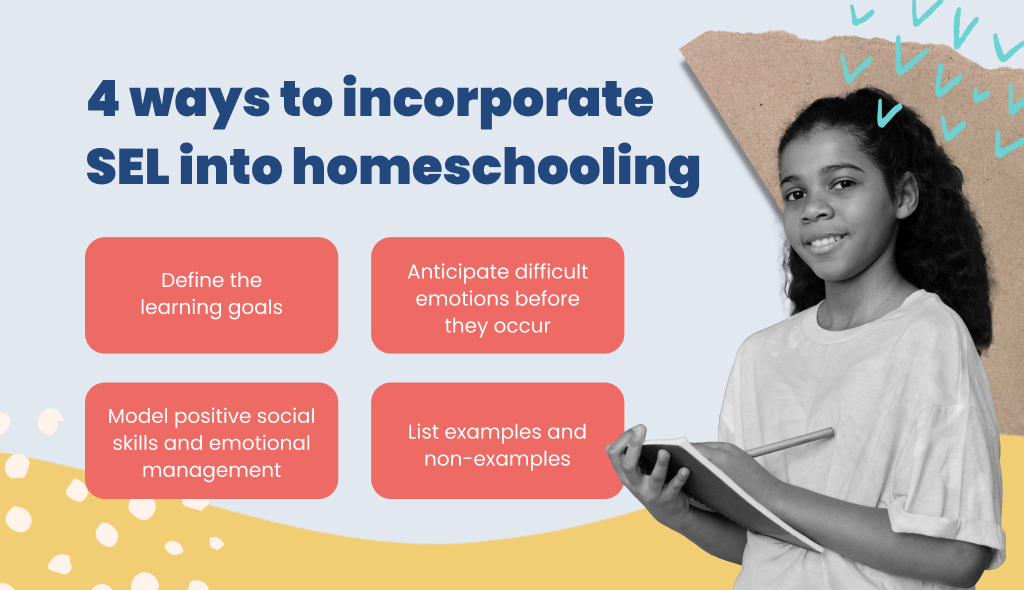A Guide to Social Emotional Learning for Homeschooling Parents

The COVID-19 pandemic brought academic learning back home, with kids of all grades studying from the couch instead of from a classroom. And as we soon found out, homeschooling presented a whole new set of opportunities and challenges.
Research suggests students had higher anxiety levels during school closures. Although this was partly induced by the stress of the pandemic, some of it also had to do with adjusting to a different learning environment.
Homeschooling in the US increased by 63% in the 2020-2021 academic year but fell by only 17% in the 2021-22 school year — meaning more children are learning at home than they were pre-pandemic.
Homeschooling parents need to ensure their children’s social and emotional well-being is taken care of while learning from home. They can do this by including social emotional learning (SEL) in their homeschool teaching practices.
Doing so will help parents support their child’s academic and emotional development while teaching them the social-emotional skills needed to integrate with the world. This article will cover some of the unique characteristics of homeschooling and suggest four ways to include social emotional learning in homeschool curricula.

The Unique Features of Homeschooling
As you may have discovered first-hand, there are a few aspects of homeschooling that pose unique opportunities and challenges for any kind of learning, including SEL. Let’s take a look at some of the most common.
The Parent-Child Bond
If you’re homeschooling your child, it’s important to factor in the uniqueness of your relationship as a teacher as well as a parent. Your child is already emotionally close to you, and that connection in most households is much stronger than in a regular teacher-student relationship.
The parent-child bond can support and facilitate learning at home — as long as things are going well. But when challenges arise — whether academic or emotional — the closeness of the relationship can make it more complicated to resolve certain situations.
For example, if your child is struggling with math, you may find yourself feeling frustrated with them. It’s important to keep those emotions in check and remember that, at this moment, you’re the teacher, and you must display the same patience and empathy that a professional teacher would in school. You want the best for your child, but you have to learn to put your feelings as a parent to one side and focus on the task at hand.
From your child’s point of view, if there’s conflict in your relationship or they feel they’re being treated unfairly, they may be less motivated to learn or push back and refuse to carry out the tasks you set for them.
On the other hand, if you provide a supportive learning environment in which the child feels seen, heard, and valued, the strength of the bond between you can support positive learning outcomes. This requires you to develop self-awareness and model the kind of self-management skills you wish to instill in your child.
Greater Curricular Freedom
Homeschooling offers you greater flexibility in structuring your lessons and building your routine around them. For example, you can decide to let your child rest up if they’re sick or not in the right frame of mind.
You don’t have to give them an entire day off, though, and can run a reduced timetable to best support your child’s needs at any given time. However, this places a greater responsibility on your shoulders to not only be good at imparting education to your child but also in managing their entire day a lot more carefully.
It’s also up to you to decide which curriculum to follow — including how to include SEL components in your teaching. While this does give you greater freedom to choose what your child learns, it can also be overwhelming trying to figure out which curriculum is most suited to their needs.
A Private Learning Environment
Homeschool is a highly individualized experience compared with regular school — your child will either be alone or in a very tight-knit group of siblings or a few friends.
While this can help them focus on their studies and build a stronger relationship with their academic curriculum, it also carries the risk of isolating them. This isolation may prevent them from developing essential life skills, such as social awareness, emotional intelligence, conflict resolution, and other key relationship skills.
This is where SEL comes in. Teaching social-emotional competencies at home can equip your child with the skills they need to develop and maintain healthy relationships.
If you’re wondering how to incorporate social emotional learning into your homeschool curriculum, read on for four ways to do just that.
4 Ways to Incorporate SEL into Homeschool Teaching
social emotional learning—according to the CASEL framework—is comprised of five pillars:
- Self-awareness
- Self-management
- Social awareness
- Relationship skills
- Responsible decision-making
Here are four ways homeschool parents can incorporate these competencies into their teaching practice.
.png)
1. Define the Learning Goals
When teaching a social-emotional skill, it’s important to let your child know what the learning objective is and why it matters, then create opportunities for them to explore and practice.
Talk to your child about the skill you’re helping them develop, explain the importance of that skill, and point out situations where they can use or practice that skill.
For example, let’s say you talk to your child about the importance of emotional self-regulation. Then, you can look for opportunities throughout the day to help them practice that skill.
Perhaps you notice your child becomes frustrated while trying to learn something new. Wait until they’re calm, then assess the situation together. Ask them to identify how they feel in their body when a task is too difficult, just right, or too easy. This helps them develop self-awareness.
Then, help them come up with some strategies they can use to calm down when they find themselves getting frustrated. Check in with your child regularly as you go through their lessons, and ask them to use their calming strategies whenever needed. This will help them develop emotional self-regulation.
2. Anticipate Difficult Emotions When They Occur
This is another way to develop self-awareness and self-management. By anticipating moments that may potentially be challenging for your child, you can help them prepare for what’s coming next. Challenges are part of life, and learning to prepare for them can make your child more resilient and bolster their emotional wellness and self-esteem.
Talk to your child about any emotions that might arise as they face this new challenge, and brainstorm strategies they can use to self-regulate throughout the process. These can be activities such as taking a walk or a few deep breaths or using a special signal to let you know they’re upset.
Walk them through the schedule before starting (it’s a good idea to sandwich a more challenging task between two easier ones) and ask them how they think they might feel during each activity or task. Remind them that they can use one of their calming strategies any time difficult emotions arise.
3. List Examples and Non-Examples
To help your child understand the SEL core competencies, they need to have a sense of what they look like in practice. Together, make a list of behaviors that align with the goal and a list of behaviors that don’t.
For example, if your child has a friend coming over to play, have them make a list of things they could do that would make their friend feel welcome — such as sharing their toys, offering them drinks and snacks, and showing them where the bathroom is when they arrive.
Then, help them identify non-examples — behaviors that would not make their friend feel welcome. This activity will help them develop social awareness and relationship skills.
4. Model Positive Social Skills and Emotional Management
Taking a “do as I say, not as I do” approach won’t cut it. Asking your child to take responsibility for their emotions and behavior requires you to do the same.
This doesn’t mean you have to be perfect or never experience negative emotions. In fact, making mistakes and then taking responsibility for them and trying to do better next time is one of the best ways to model social-emotional skills.
For example, if you lose your temper with your partner, start by identifying your own emotions and choosing a self-regulation strategy that works for you. Then, describe to your child what emotions you’re feeling and what you’re going to do to calm yourself down.
Once you’re calm, explain how your emotions affected your behavior and remind them it’s okay to experience these emotions — but it’s important to handle them in an adequate manner. Tell them what you plan to do to repair the situation or do things differently next time.

Get SEL Support for Homeschooling with Lessonbee
In spite of its challenges, homeschooling is a great opportunity for you to support your child’s social-emotional development.
If you’re ready to start incorporating SEL-focused activities into your homeschool curriculum, check out Lessonbee’s homeschooling solutions for parents.
Lessonbee provides the resources, support, and tools parents need to successfully implement SEL in a homeschool environment. Sign up for a free trial to gain immediate access to our content library and other resources.
Subscribe to get notified on Lessonbee updates and new blog posts







